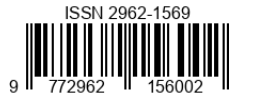Studi Pengetahuan Mahasiswa Tentang Dampak Makanan Cepat Saji di Universitas Almarisah Madani
DOI:
https://doi.org/10.57214/jusika.v8i2.688Keywords:
Knowledge, fast, food, StudentsAbstract
Fast food is a top choice because it is convenient, time-saving, and can be enjoyed anytime and anywhere. In addition, it is served in a hygienic environment and is considered a prestigious and modern food, especially among young people. In Indonesia, fast food consumption is increasing, based on research from the Directorate of Public Nutrition, Ministry of Health of the Republic of Indonesia, it was recorded that in 2000, out of a total population of 210 million, around 76.7 million were overweight and more than 9.8 million were obese. This study aims to determine the level of understanding of students about the impact of fast food consumption in the DIII Midwifery Study Programme at Almarisah Madani University. The method used in this research is qualitative research with a total sample of 48 people selected using the total sampling technique. The results showed that of the 48 respondents, 43 students (89.58%) had a good level of understanding, 4 students (8.33%) had sufficient understanding, and 1 student (2.09%) had less understanding. Thus, the majority of students have good knowledge about the impact of fast food consumption.
References
Almatsier, S. (2014). Prinsip Dasar Ilmu Gizi. Jakarta: Gramedia Pustaka Umum
Brown, K., 2019. Fast Food and Public Health: A Systematic Review. Journal of Health Research, 27(2), 78-90 FAO, (2017). Food and Nutrition in Developing Countries. Rome: Food and Agriculture Organization
Ending (2011). Metode Penelitian Terapan Bidang Pendidikan.Bandung:alfabeta.
Hatta, H. (2019). Hubungan Konsumsi Fast Food Dengan Status Gizi Siswa Di SMP Negeri 1 Limboto Barat. Afiasi : Jurnal Kesehatan Masyarakat, 4(2), 41.https://doi.org/10.31943/afiasi.v4i2.
Ida Cholidatul, (2016). Kebiasaan Komsumsi Makanan Cepat Saji pasa Siswa Kelas VIII SMP Yogyakarta.Unifersitas Yogyakarta.
Karnaini, (2012). Negri Hubungan 1 Negeri Antara Kebiasaan komsumsi makanan cepat saji modern pada aktifitas, fisik dan factor lainnya dengan status gizi pada remaja. FKM UI. Depok.
Kemenkes RI , (2013). laporan Hasil Riset Kesehatan Dasar Indonesia.Jakarta (riskesdes)
Khumaidi, (2012). Status Gizi Remaja Usia Aktif. Bandung: Remaja Rosdakarya.
Kuraifah, (2014). Pengaruh daya tarik makanan cepat saji di Televisi perilaku komsumsi makanan pada mahasiswa kos. Universitas Yogyakarta.Yogyakarta. Neger
Lutfi, (2012). Makanan teratur mahasiswa tingkat akhir. http:/lutibrully.com November 2018. Dikutip diakses dari 10
Mozaffarian, D., (2016). Dietary and Policy Priorities for Cardiovascular Disease, Diabetes, and Obesity. Circulation, 133(2), 187-225
Notoatmodjo, (2011). Promosi Kesehatan. Jakarta: Rineka Cipta.
Notoatmodjo, (2012). Metodologi penelitian kesehatan. Jakarta: Rineka Cipta.
Nursalam, (2015). Metodologi penelitian pendekatan praktis. Jakarta: Selemba Medika.
Permana, L., Afiah;, N., Ifroh;, R. H., & Wiranto, A. (2020). Analisis Status Gizi , Kebiasaan Makan Dan Aktivitas Fisik Pada Mahasiswa Kesehatan Dengan Pendekatan MixMethod tergambar dari data Global School merupakan usia remaja akhir , yang makan saji , menjadikan. Jurnal Kesehatan, 10(2), 19–34
Rizka Amelia Nur Hilal, (2014). Laporan Ilmiah Fast Food. Diakses dari http://rizkaamalianurhilal.co.id/2014/0 1/laporan-ilmiah-fastfood.html.diakses tanggal 19 Nvember 2018. Williams, L., 2021. Obesity and Fast Food: Analyzing the Correlation. Global Journal of Public Health, 19(4), 225 240.
Smith, J., (2020). The Impact of Fast Food Consumption on Adolescent Health. International Journal of Nutrition Studies, 45(3), 112-125
Sulistiyani, D.A. (2022). Maraknya Makanan Cepat Saji (Dilihat dari aspek Epidemiologi) Karya Tulis Ilmiah. http//pateron.org/1016/04/pengaruh makanan siap saji








